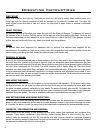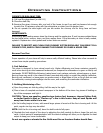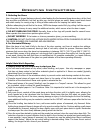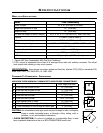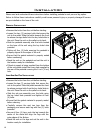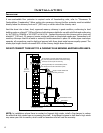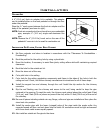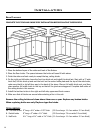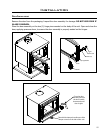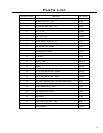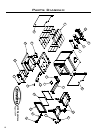
11
Installation
CHIMNEY INSTALLATION THROUGH WALL:
Here are four methods of combustible wall chimney connector pass-throughs. This information was provided from
NFPA 211.
Method A. 12” (304.8 mm) Clearance to Combustible Wall
Member: Using a minimum thickness 3.5” (89 mm) brick and
a ” (15.9 mm) minimum wall thickness clay liner, construct a
wall pass-through. The clay liner must conform to ASTM C315
(Standard Specication for Clay Fire Linings) or its equivalent. Keep
a minimum of 12” (305 mm) of brick masonry between the clay
liner and wall combustibles. The clay liner shall run from the brick
masonry outer surface to the inner surface of the chimney ue liner
but not past the inner surface. Firmly grout or cement the clay liner
in place to the chimney ue liner.
Method B. 9” (229 mm) Clearance to Combustible Wall Member:
Using a 6” (152 mm) inside diameter, factory-built Solid-Pak chimney
section with insulation of 1” (25.4 mm) or more, build a wall pass-
through with a minimum 9” (229 mm) air space between the outer
wall of the chimney length and wall combustibles. Use sheet metal
supports fastened securely to wall surfaces on all sides, to maintain
the 9” (229 mm) air space. When fastening supports to chimney
length, do not penetrate the chimney liner (the inside wall of the
Solid-Pak chimney). The inner end of the Solid-Pak chimney section
shall be ush with the inside of the masonry chimney ue, and
sealed with a non-water soluble refractory cement. Use this cement to also seal to the brick masonry penetration.
Minimum12inches
(304.8mm)tocombustibles
Minimumclearance
12inches(304.8mm)
ofbrick
Minimumchimneyclearancetobrick
andcombustibles2inches(50.8mm)
Chimney
connector
Fireclayliner
Masonry
chimney
}
}
ChimneyFlue
A
D
Twoventilatedairchannels
each1inch(25.4mm).
Constructionofsheetsteel
Chimney
connector
Minimum6inches
(152.4mm)glass
fiberinsulation
}
Sheetsteel
supportrs
Twoairchannelseach
1inch(25.4mm)
}
Minimumchimneyclearancetosheetsteel
supportsandcombustibles2inches(50.8mm)
Chimneyflue
Masonry
chimney
}
C
Factory-built
chimneylength
Chimneylength
flushwithinside
offlue
Solid-insulated,
listedfactory-built
chimneylength
Usechimney
manufacturer’s
partstoattach
connectorsecurely
}
Chimney
flue
Chimney
connector
Minimumclearance
9inches(228.6mm)
Airspace9inches
(228.6mm)minimum
Minimumchimneyclearancefrommasonrytosheet
steelsupportsandcombustibles2inches(50.8mm)
Masonrychimney
}
Sheetsteelsupports
Non-soluble
retractory
cement
B
Method C
. 6” (152.4 mm) Clearance to Combustible Wall Member
:
Starting with a minimum 24 gauge (.024” [0.6 mm]) 6” (152.4 mm)
metal chimney connector, and a minimum 24 gauge ventilated wall
thimble which has two air channels of 1” (25.4 mm) each, construct
a wall pass-through. There shall be a minimum 6” (152.4 mm)
separation area containing berglass insulation, from the outer
surface of the wall thimble to wall combustibles. Support the wall
thimble, and cover its opening with a 24 gauge minimum sheet
metal support. Maintain the 6” (152.4 mm) space. There should
also be a support sized to t and hold the metal chimney connector.
See that the supports are fastened securely to wall surfaces on all
sides. Make sure fasteners used to secure the metal chimney connector do not penetrate chimney ue liner.
Method D
. 2” (50.8 mm) Clearance to Combustible Wall Member:
Start with a solid-pak listed factory built chimney section at least
12” (304 mm) long, with insulation of 1” (25.4 mm) or more, and
an inside diameter of 8” (2” [51 mm] larger than the 6” [152.4 mm]
chimney connector). Use this as a pass-through for a minimum 24
gauge single wall steel chimney connector. Keep solid-pak section
concentric with and spaced 1” (25.4 mm) off the chimney connector
by way of sheet metal support plates at both ends of chimney
section. Cover opening with and support chimney section on both
sides with 24 gauge minimum sheet metal supports. See that the
supports are fastened securely to wall surfaces on all sides. Make
sure fasteners used to secure chimney ue liner.
NOTES:
1. Connectors to a masonry chimney, excepting method B, shall extend in one continuous section through the wall
pass-through system and the chimney wall, to but not past the inner ue liner face.
2. A chimney connector shall not pass through an attic
or roof space, closet or similar concealed space, or a oor,
or ceiling.




